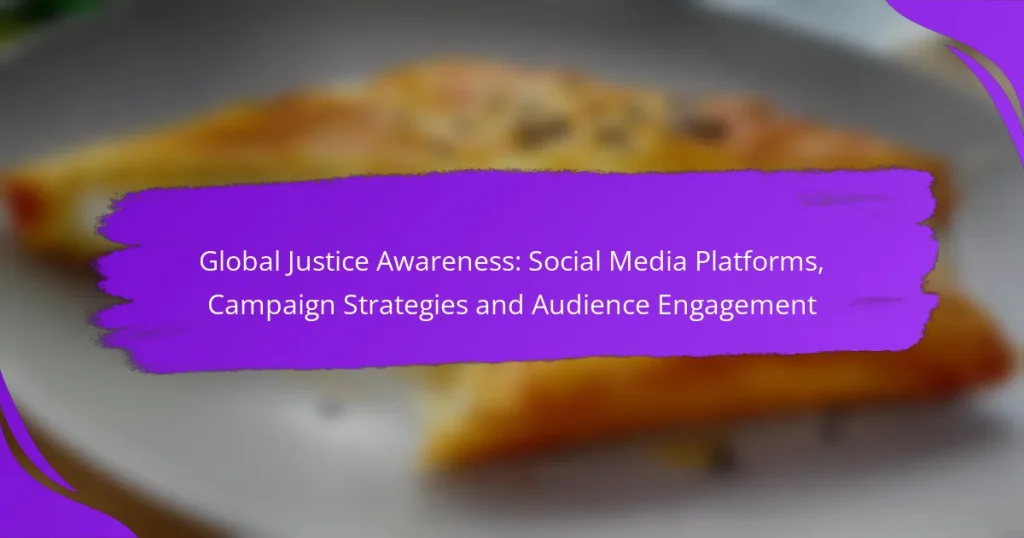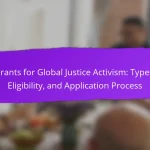Social media platforms play a crucial role in raising global justice awareness by facilitating advocacy, education, and community engagement. Through effective campaign strategies such as hashtag movements and influencer partnerships, these platforms enable organizations to mobilize support and connect with audiences worldwide. Engaging individuals in these initiatives requires a thoughtful approach that incorporates interactive elements and community involvement, fostering deeper connections and motivating active participation in social justice causes.
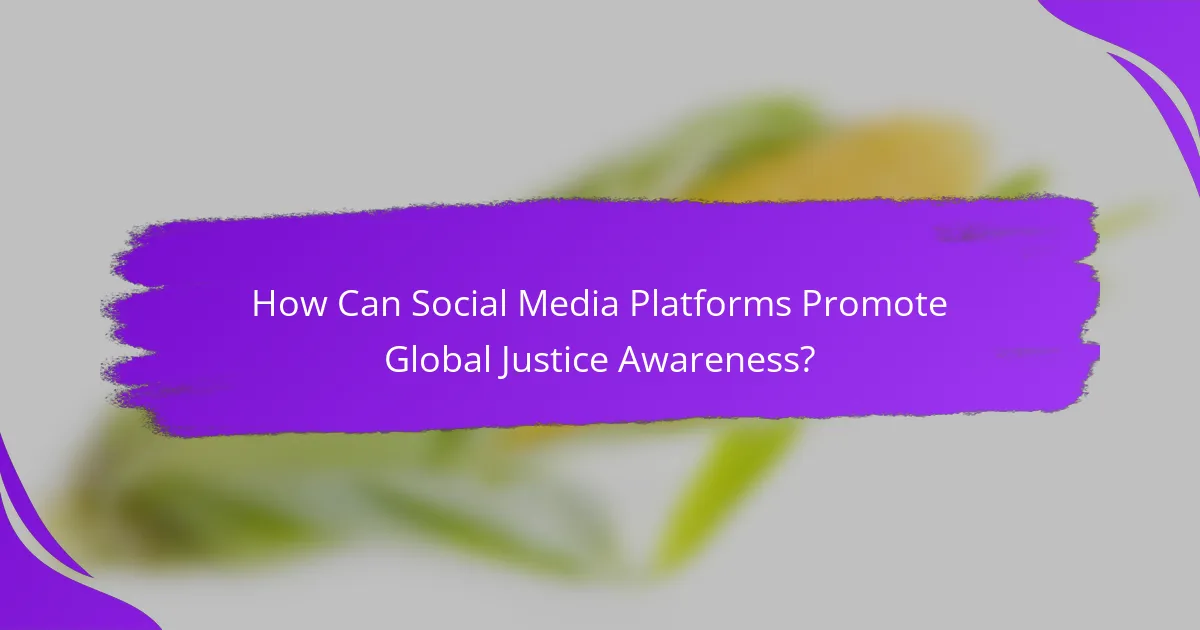
How Can Social Media Platforms Promote Global Justice Awareness?
Social media platforms can significantly enhance global justice awareness by providing a space for advocacy, education, and community engagement. They enable users to share information, mobilize support, and connect with like-minded individuals across the globe.
Facebook campaigns
Facebook campaigns leverage the platform’s vast user base to raise awareness about global justice issues. Organizations can create targeted ads, events, and groups to engage users in discussions and actions related to social justice.
Effective campaigns often include compelling visuals and personal stories that resonate with audiences. Utilizing Facebook Live for real-time discussions or Q&A sessions can further enhance engagement.
Twitter activism
Twitter activism allows for rapid dissemination of information and mobilization of support for global justice causes. The platform’s character limit encourages concise messaging, making it ideal for sharing impactful quotes, statistics, and calls to action.
Using relevant hashtags can help amplify messages and connect with broader movements. Engaging with influencers and participating in trending discussions can also increase visibility and support for campaigns.
Instagram storytelling
Instagram storytelling focuses on visual content to convey messages about global justice. Users can share powerful images and videos that highlight injustices, making the issues more relatable and urgent.
Incorporating features like Stories and Reels allows for dynamic storytelling that can engage audiences over time. Collaborating with artists and creators can also enhance the emotional impact of the content.
LinkedIn professional networks
LinkedIn serves as a platform for professionals to discuss and advocate for global justice within their industries. It allows users to share articles, insights, and case studies that highlight the importance of social responsibility.
Networking with like-minded professionals can lead to collaborative initiatives and corporate social responsibility programs. Engaging in discussions in relevant groups can also raise awareness among industry leaders.
YouTube educational content
YouTube is a powerful tool for educating audiences about global justice issues through in-depth videos and documentaries. Content creators can explore complex topics, providing context and analysis that promote understanding and empathy.
Creating playlists that compile various perspectives on a single issue can encourage viewers to engage more deeply. Collaborating with experts and activists can enhance credibility and reach a wider audience.
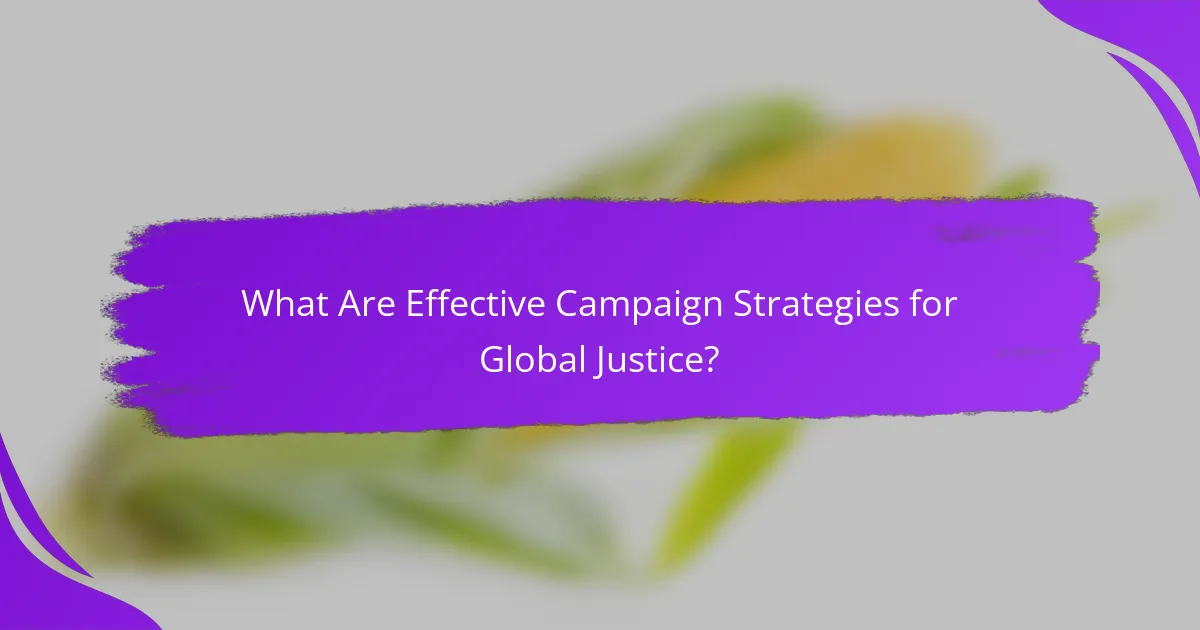
What Are Effective Campaign Strategies for Global Justice?
Effective campaign strategies for global justice leverage social media to raise awareness, mobilize support, and drive action. Key approaches include hashtag movements, influencer partnerships, petition drives, and awareness events, each designed to engage audiences and amplify messages.
Hashtag movements
Hashtag movements are powerful tools for uniting voices around a common cause. They allow individuals to share their experiences and opinions while increasing visibility on social media platforms. Successful movements often create a sense of community and urgency, encouraging participation and sharing.
To launch a hashtag movement, choose a concise and memorable hashtag that resonates with your audience. Promote it across various platforms and encourage supporters to use it in their posts. Monitor engagement and adapt your strategy based on audience feedback and trends.
Influencer partnerships
Collaborating with influencers can significantly expand the reach of global justice campaigns. Influencers have established trust and credibility with their followers, making their endorsements impactful. Selecting the right influencers who align with your cause is crucial for authenticity.
When forming partnerships, consider micro-influencers who may have smaller but highly engaged audiences. Develop clear guidelines for the collaboration to ensure that the messaging remains consistent and resonates with both the influencer’s audience and your campaign goals.
Petition drives
Petition drives mobilize support for specific actions or policy changes, providing a tangible way for individuals to express their commitment to global justice. They can be conducted online or offline and often serve as a catalyst for larger movements.
To create an effective petition, clearly articulate the issue and the desired outcome. Use platforms like Change.org to reach a broader audience and make it easy for supporters to sign and share. Aim for a realistic target number of signatures to demonstrate significant backing for your cause.
Awareness events
Awareness events are essential for educating the public and generating interest in global justice issues. These events can take many forms, including workshops, webinars, rallies, or social media campaigns, and they provide opportunities for direct engagement.
When organizing an awareness event, focus on creating an inclusive atmosphere that encourages participation. Utilize social media to promote the event and share key takeaways afterward. Consider incorporating interactive elements, such as Q&A sessions or live discussions, to foster deeper connections with attendees.
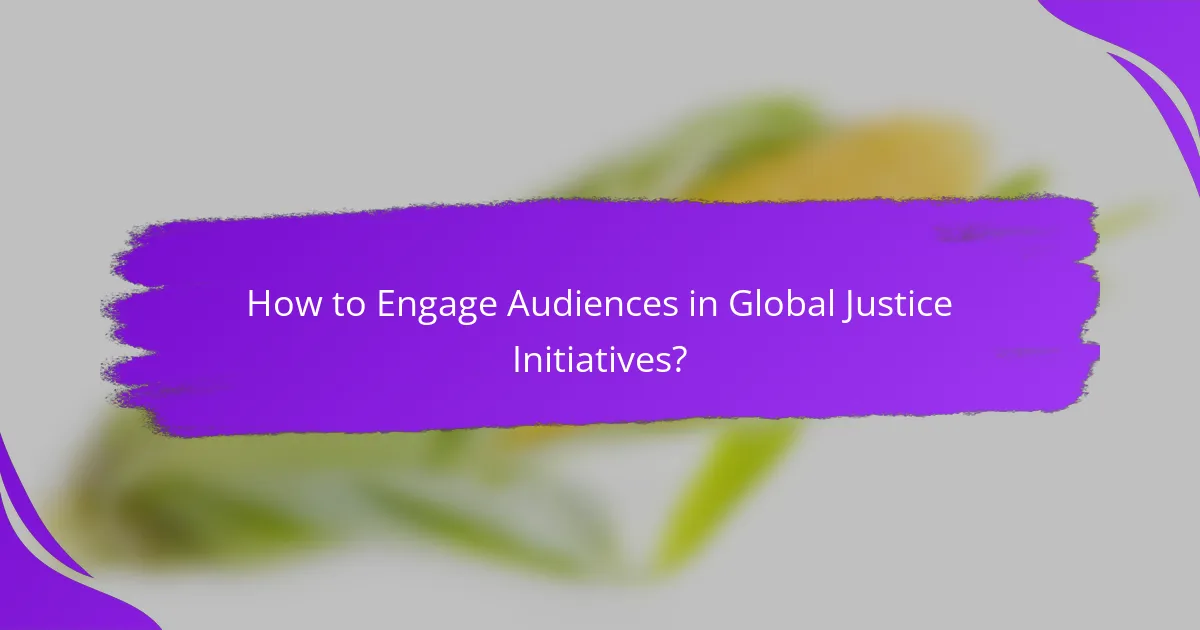
How to Engage Audiences in Global Justice Initiatives?
Engaging audiences in global justice initiatives requires a strategic approach that combines interactive elements, community involvement, and feedback mechanisms. By utilizing these methods, organizations can foster deeper connections and motivate individuals to participate actively in social justice causes.
Interactive content
Interactive content, such as quizzes, polls, and infographics, can significantly enhance audience engagement. This type of content encourages users to participate actively rather than passively consuming information, making them feel more connected to the cause.
For example, a quiz that assesses knowledge about global justice issues can spark interest and encourage sharing on social media platforms. Aim for content that is visually appealing and easy to share, as this can amplify reach and impact.
Community building
Building a community around global justice initiatives fosters a sense of belonging and shared purpose. Utilize social media groups, forums, or dedicated platforms to create spaces where individuals can discuss, share experiences, and collaborate on projects.
Consider organizing regular online events, such as webinars or virtual meetups, to strengthen community ties. Encourage members to share their stories and insights, which can enhance engagement and attract new participants.
Feedback loops
Establishing feedback loops is crucial for understanding audience needs and improving engagement strategies. Regularly solicit input from participants through surveys, comment sections, or direct messages to gauge their interests and concerns.
Implementing changes based on feedback not only shows that you value your audience’s opinions but also helps tailor initiatives to better meet their expectations. This responsiveness can significantly boost loyalty and participation rates.
Gamification techniques
Gamification techniques, such as leaderboards, badges, and challenges, can make participation in global justice initiatives more engaging and fun. By incorporating game-like elements, you can motivate individuals to take action and compete for recognition.
For instance, creating a challenge where participants earn points for sharing content or attending events can drive engagement. Ensure that rewards are meaningful and relevant to the cause, as this can enhance motivation and commitment to the initiative.
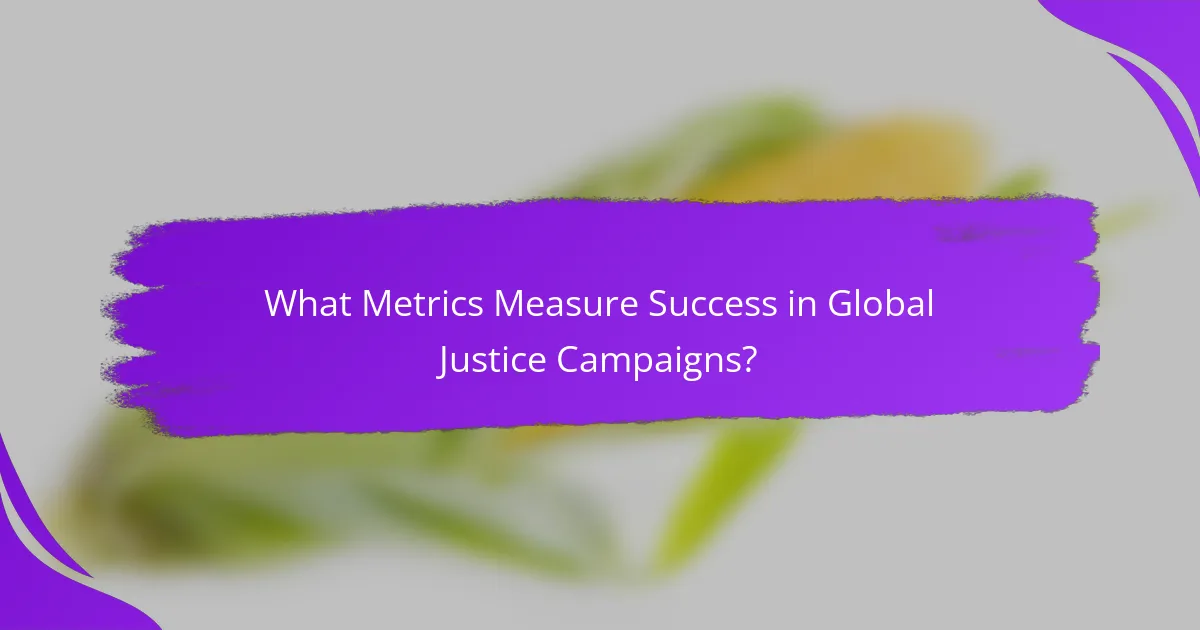
What Metrics Measure Success in Global Justice Campaigns?
Success in global justice campaigns can be measured through various metrics that reflect audience engagement and conversion effectiveness. Key indicators include engagement rates and conversion metrics, which provide insights into how well a campaign resonates with its audience and drives desired actions.
Engagement rates
Engagement rates gauge how actively audiences interact with campaign content across social media platforms. This includes likes, shares, comments, and overall reach, which can indicate the level of interest and connection with the campaign’s message.
To evaluate engagement, consider tracking metrics like the percentage of followers who interact with posts, which can range from single digits to over 20% depending on the platform and content quality. High engagement rates often correlate with effective messaging and audience alignment.
Common pitfalls include focusing solely on follower counts instead of interactions. Prioritize content that encourages dialogue and sharing to enhance engagement rates.
Conversion metrics
Conversion metrics measure the effectiveness of a campaign in prompting specific actions, such as donations, sign-ups, or advocacy participation. These metrics help assess whether the campaign successfully motivates its audience to take meaningful steps toward supporting global justice initiatives.
Key conversion metrics include the conversion rate, which is the percentage of engaged users who complete a desired action. A typical conversion rate for online campaigns might range from 1% to 5%, depending on the clarity of the call-to-action and the audience’s motivation.
To improve conversion rates, ensure that calls-to-action are clear and compelling. Avoid overwhelming users with too many options, as this can dilute focus and reduce overall conversions. Regularly analyze and adjust strategies based on performance data to optimize outcomes.
